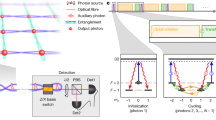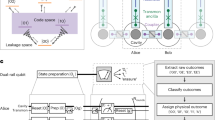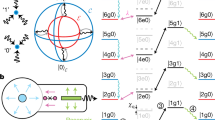Abstract
Multipartite entanglement is essential for quantum computation1 and communication2,3,4, and for fundamental tests of quantum mechanics5 and precision measurements6. It has been achieved with various forms of quantum bits (qubits), such as trapped ions7,8, photons9 and atoms passing through microwave cavities10. Quantum systems based on superconducting circuits, which are potentially more scalable, have been used to control pair-wise interactions of qubits11,12,13,14,15,16 and spectroscopic evidence for three-particle entanglement was observed17,18. Here, we report the demonstration of coherent interactions in the time domain for three directly coupled superconducting quantum systems, two phase qubits and one resonant cavity. We provide evidence for the deterministic evolution from a simple product state, through a tripartite W state, into a (bipartite) Bell state. The cavity can be thought of as a multiphoton register or an entanglement bus, and arbitrary preparation of multiphoton states in this cavity using one of the qubits19 and subsequent interactions for entanglement distribution should allow for the deterministic creation of another class of entanglement, a Greenberger–Horne–Zeilinger state.
This is a preview of subscription content, access via your institution
Access options
Subscribe to this journal
Receive 12 print issues and online access
$259.00 per year
only $21.58 per issue
Buy this article
- Purchase on SpringerLink
- Instant access to full article PDF
Prices may be subject to local taxes which are calculated during checkout




Similar content being viewed by others
References
Gottesman, D. & Chuang, I. L. Demonstrating the viability of universal quantum computation using teleportation and single-qubit operations. Nature 402, 390–393 (1999).
Karlsson, A. & Bourennane, M. Quantum teleportation using three-particle entanglement. Phys. Rev. A 58, 4394–4400 (1998).
Briegel, H. J., Dür, W., Cirac, J. & Zoller, P. Quantum repeaters: The role of imperfect local operations in quantum communication. Phys. Rev. Lett. 81, 5932–5935 (1998).
Hillery, M., Buzek, V. & Berthiaume, A. Quantum secret sharing. Phys. Rev. A 59, 1829–1834 (1999).
Greenberger, D. M., Horne, M. A. & Zeilinger, A. Multiparticle interferometry and the superposition principle. Phys. Today 46, 22–29 (1993).
Giovannetti, V., Lloyd, S. & Maccone, L. Quantum-enhanced measurements: Beating the standard quantum limit. Science 306, 1330–1336 (2004).
Leibfried, D. et al. Creation of a six-atom Schrödinger cat state. Nature 438, 639–641 (2005).
Roos, C. F. et al. Control and measurement of three-qubit entangled states. Science 304, 1478–1482 (2004).
Pan, J-W., Bouwmeester, D., Daniell, M., Weinfurter, H. & Zeilinger, A. Experimental test of quantum nonlocality in three-photon Greenberger–Horne–Zeilinger entanglement. Nature 403, 515–519 (2000).
Rauschenbeutel, A. et al. Step-by-step engineered multiparticle entanglement. Science 288, 2024–2028 (2000).
Pashkin, Y. A. et al. Quantum oscillations in two coupled charge qubits. Nature 421, 823–826 (2003).
McDermott, R. et al. Simultaneous state measurement of coupled Josephson phase qubits. Science 307, 1299–1302 (2005).
Steffen, M. et al. Measurement of the entanglement of two superconducting qubits via state tomography. Science 313, 1423–1425 (2006).
Sillanpää, M. A., Park, J. I. & Simmonds, R. W. Coherent quantum state storage and transfer between two phase qubits via a resonant cavity. Nature 449, 438–442 (2007).
DiCarlo, L. et al. Demonstration of two-qubit algorithms with a superconducting quantum processor. Nature 460, 240–244 (2009).
Niskanen, A. O. et al. Quantum coherent tunable coupling of superconducting qubits. Science 316, 723–726 (2007).
Xu, H. et al. Spectroscopy of three-particle entanglement in a macroscopic superconducting circuit. Phys. Rev. Lett. 94, 027003 (2005).
Fink, J. M. et al. Dressed collective qubit states and the Tavis–Cummings model in circuit QED. Phys. Rev. Lett. 103, 083601 (2009).
Hofheinz, M. et al. Synthesizing arbitrary quantum states in a superconducting resonator. Nature 459, 546–549 (2009).
Hao, C-F., Li, J-C. & Guo, G-C. Controlled dense coding using the Greenberger–Horne–Zeilinger state. Phys. Rev. A 63, 054301 (2001).
Borsten, L., Dahanayake, D., Duff, M. J., Ebrahim, H. & Rubens, W. Wrapped branes as qubits. Phys. Rev. Lett. 100, 251602 (2008).
Dür, W., Vidal, G. & Cirac, J. Three qubits can be entangled in two inequivalent ways. Phys. Rev. A 62, 062314 (2000).
Wei, L. F., Liu, Y-x. & Nori, F. Greenberger–Horne–Zeilinger entanglement in superconducting circuits. Phys. Rev. Lett. 96, 246803 (2006).
Galiautdinov, A. & Martinis, J. M. Maximally entangling tripartite protocols for Josephson phase qubits. Phys. Rev. A 78, 010305 (2008).
Kim, M. D. & Cho, S. Y. Macroscopic Greenberger–Horne–Zeilinger and W states in flux qubits. Phys. Rev. B 77, 100508(R) (2008).
Simmonds, R. W. et al. Decoherence in Josephson phase qubits from junction resonators. Phys. Rev. Lett. 93, 077003 (2004).
Tavis, M. & Cummings, F. W. Exact solution for an n-molecule-radiation-field Hamiltonian. Phys. Rev. 170, 379–384 (1968).
Simmonds, R. W. et al. Coherent interactions between phase qubits, cavities, and TLS defects. Quant. Inform. Process. 8, 117–131 (2009).
Martinis, J. M. et al. Decoherence in Josephson qubits from dielectric loss. Phys. Rev. Lett. 95, 210503 (2005).
Cooper, K. B. et al. Observation of quantum oscillations between a Josephson phase qubit and a microscopic resonator using fast readout. Phys. Rev. Lett. 93, 180401 (2004).
Blais, A. et al. Quantum-information processing with circuit quantum electrodynamics. Phys. Rev. A 75, 032329 (2007).
Neeley, M. et al. Generation of three-qubit entangled states using superconducting phase qubits. Preprint at http://arxiv.org/abs/1004.4246 (2010).
Dicarlo, L. et al. Preparation and measurement of three-qubit entanglement in a superconducting circuit. Preprint at http://arxiv.org/abs/1004.4324 (2010).
Acknowledgements
This work was financially supported by NIST and in part by IARPA. M.A.S. was supported by the Academy of Finland and by the European Research Council (grant no. FP7-240387).
Author information
Authors and Affiliations
Contributions
F.A., J.I.P., M.A.S. and R.W.S. developed the experiment. F.A. carried out the experiment. J.I.P. carried out the theoretical simulations. K.C. fabricated the device. J.D.W. developed the acquisition software. All authors discussed the results and contributed to the manuscript. F.A., J.I.P. and R.W.S. wrote the manuscript.
Corresponding author
Ethics declarations
Competing interests
The authors declare no competing financial interests.
Rights and permissions
About this article
Cite this article
Altomare, F., Park, J., Cicak, K. et al. Tripartite interactions between two phase qubits and a resonant cavity. Nature Phys 6, 777–781 (2010). https://doi.org/10.1038/nphys1731
Received:
Accepted:
Published:
Issue date:
DOI: https://doi.org/10.1038/nphys1731
This article is cited by
-
Vectorial polaritons in the quantum motion of a levitated nanosphere
Nature Physics (2021)
-
Cavity control as a new quantum algorithms implementation treatment
Frontiers of Physics (2018)
-
Generation of a macroscopic entangled coherent state using quantum memories in circuit QED
Scientific Reports (2016)
-
Transferring multipartite entanglement among different cavities
Quantum Information Processing (2016)
-
Generating multipartite entangled states of qubits distributed in different cavities
Quantum Information Processing (2014)



